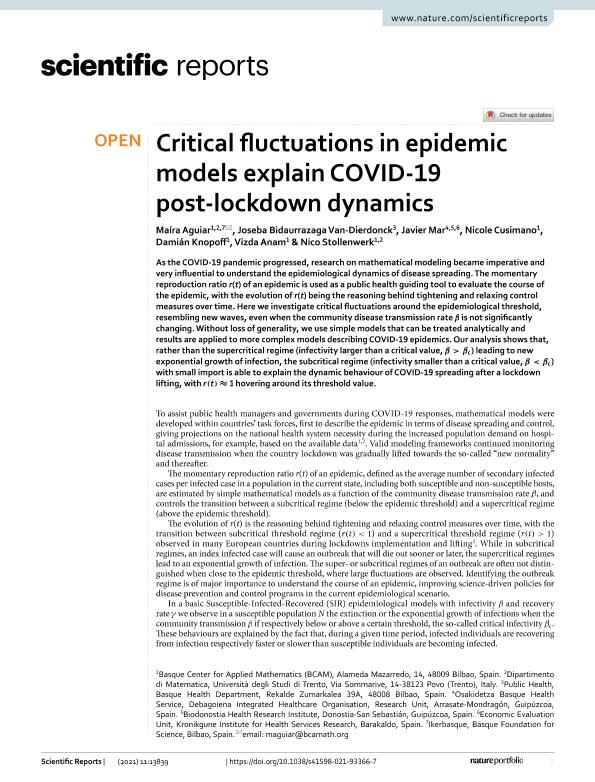Artículo
Critical fluctuations in epidemic models explain COVID-19 post-lockdown dynamics
Aguiar, Maíra; Van Dierdonck, Joseba Bidaurrazaga; Mar, Javier; Cusimano, Nicole; Knopoff, Damián Alejandro ; Anam, Vizda; Stollenwerk, Nico
; Anam, Vizda; Stollenwerk, Nico
 ; Anam, Vizda; Stollenwerk, Nico
; Anam, Vizda; Stollenwerk, Nico
Fecha de publicación:
12/2021
Editorial:
Nature Research
Revista:
Scientific Reports
e-ISSN:
2045-2322
Idioma:
Inglés
Tipo de recurso:
Artículo publicado
Clasificación temática:
Resumen
As the COVID-19 pandemic progressed, research on mathematical modeling became imperative and very influential to understand the epidemiological dynamics of disease spreading. The momentary reproduction ratio r(t) of an epidemic is used as a public health guiding tool to evaluate the course of the epidemic, with the evolution of r(t) being the reasoning behind tightening and relaxing control measures over time. Here we investigate critical fluctuations around the epidemiological threshold, resembling new waves, even when the community disease transmission rate β is not significantly changing. Without loss of generality, we use simple models that can be treated analytically and results are applied to more complex models describing COVID-19 epidemics. Our analysis shows that, rather than the supercritical regime (infectivity larger than a critical value, β> βc) leading to new exponential growth of infection, the subcritical regime (infectivity smaller than a critical value, β< βc) with small import is able to explain the dynamic behaviour of COVID-19 spreading after a lockdown lifting, with r(t) ≈ 1 hovering around its threshold value.
Palabras clave:
EPIDEMIOLOGICAL MODELS
,
COVID-19
,
CRITICAL FLUCTUATIONS
,
STOCHASTIC MODELS
Archivos asociados
Licencia
Identificadores
Colecciones
Articulos(CIEM)
Articulos de CENT.INV.Y ESTUDIOS DE MATEMATICA DE CORDOBA(P)
Articulos de CENT.INV.Y ESTUDIOS DE MATEMATICA DE CORDOBA(P)
Citación
Aguiar, Maíra; Van Dierdonck, Joseba Bidaurrazaga; Mar, Javier; Cusimano, Nicole; Knopoff, Damián Alejandro; et al.; Critical fluctuations in epidemic models explain COVID-19 post-lockdown dynamics; Nature Research; Scientific Reports; 11; 13839; 12-2021; 1-12
Compartir
Altmétricas



